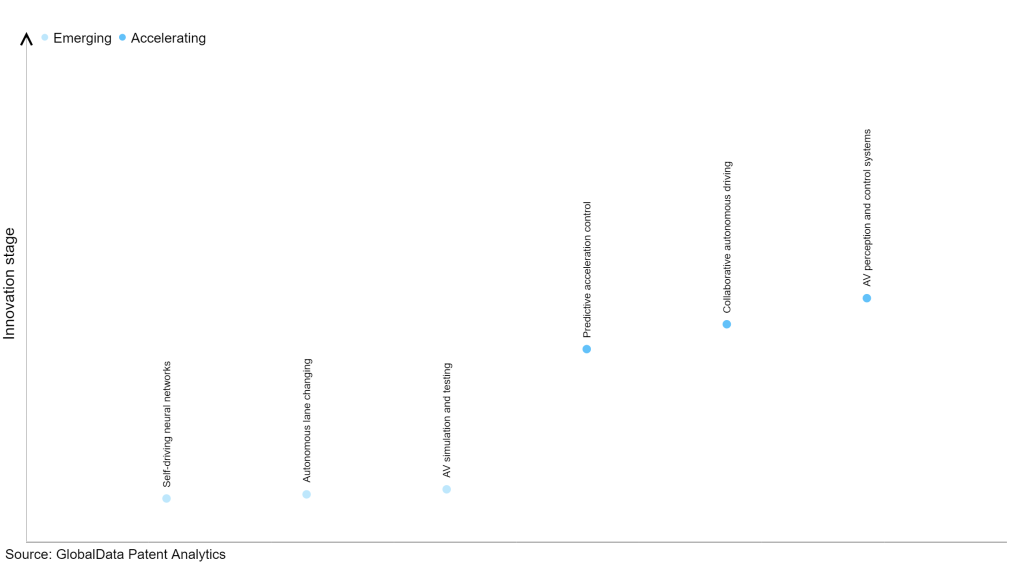The automotive industry continues to be a hotbed of patent innovation. Activity is driven by the demand for better customer experience, rising interest driver safety in vehicles, autonomous driving, safety features, testing and simulation, and growing importance of technologies such as advanced signal/image processing algorithms and predictive AI-based analytics. In the last three years alone, there have been over 720,000 patents filed and granted in the automotive industry, according to GlobalData’s report on Artificial intelligence in automotive: driver drowsiness detection. Buy the report here.
However, not all innovations are equal and nor do they follow a constant upward trend. Instead, their evolution takes the form of an S-shaped curve that reflects their typical lifecycle from early emergence to accelerating adoption, before finally stabilizing and reaching maturity.
Identifying where a particular innovation is on this journey, especially those that are in the emerging and accelerating stages, is essential for understanding their current level of adoption and the likely future trajectory and impact they will have.
300+ innovations will shape the automotive industry
According to GlobalData’s Technology Foresights, which plots the S-curve for the automotive industry using innovation intensity models built on over one million patents, there are 300+ innovation areas that will shape the future of the industry.
Within the emerging innovation stage, self-driving neural networks, autonomous lane changing and AV simulation and testing are disruptive technologies that are in the early stages of application and should be tracked closely. Predictive acceleration control, collaborative autonomous driving, and AV perception and control systems are some of the accelerating innovation areas, where adoption has been steadily increasing.
Innovation S-curve for artificial intelligence in the automotive industry

Driver drowsiness detection is a key innovation area in artificial intelligence
Driver drowsiness detection systems use cameras, eye tracking sensors and other hardware to track visual cues, where drowsiness can be identified through eye-blinking frequency, facial expressions, yawning frequency, eye-gaze movement and head movement.
GlobalData’s analysis also uncovers the companies at the forefront of each innovation area and assesses the potential reach and impact of their patenting activity across different applications and geographies. According to GlobalData, there are 225+ companies, spanning technology vendors, established automotive companies, and up-and-coming start-ups engaged in the development and application of driver drowsiness detection.
Key players in driver drowsiness detection – a disruptive innovation in the automotive industry
‘Application diversity’ measures the number of applications identified for each patent. It broadly splits companies into either ‘niche’ or ‘diversified’ innovators.
‘Geographic reach’ refers to the number of countries each patent is registered in. It reflects the breadth of geographic application intended, ranging from ‘global’ to ‘local’.
Patent volumes related to driver drowsiness detection
Source: GlobalData Patent Analytics
Toyota Motor is the leading patent filer in the driver drowsiness detection innovation area. The company’s Toyota Safety Sense alerts drivers about the dangers of DWS – Driving While Sleepy. It is designed to support a driver’s awareness and increase safety while driving. Hyundai Motor, LG, Kia, and Denso are some of the other key players in the innovation area.
In terms of application diversity, Forvia held the top position, while Beijing Electronics and Shanghai SenseTime Intelligent Technology stood in second and third positions, respectively. By means of geographic reach, State Farm Mutual Automobile Insurance leads the pack, followed by Yokohama Rubber and ResMed.
To further understand how artificial intelligence is disrupting the automotive industry, access GlobalData’s latest thematic research report on Artificial Intelligence (AI) in Automotive.
Data Insights
From

The gold standard of business intelligence.
Blending expert knowledge with cutting-edge technology, GlobalData’s unrivalled proprietary data will enable you to decode what’s happening in your market. You can make better informed decisions and gain a future-proof advantage over your competitors.



